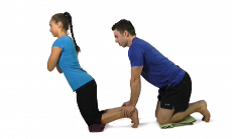Blog Categories
Search Blog
Blog Categories
Stubborn Hamstring Injuries
You are not alone if you have ever experienced a hamstring injury. In fact, hamstring injuries are the most prevalent and frequent injuries in sports that require sprinting, running, cutting, power and agility (Opar et al., 2012; Schmitt et al., 2012). At the professional level, hamstring injuries cost football clubs, rugby clubs and professional athletes millions of dollars every year (Opar et al., 2012). These injuries are painful, debilitating and frustrating; not to mention long periods of time away from a beloved activity. There are many reasons why hamstrings injuries happen (fatigue, muscle imbalance, flexibility, poor technique, inadequate recovery, muscle anatomy and physiology), and unfortunately, a previous hamstring injury is the number one predictor of re-injury (Schmitt et al., 2012).
How Does the Injury Happen in the First Place?
The Hamstring muscle is composed of three muscles: semimembranosus, semitendinosus and the biceps femoris. They originate on the pelvis and insert below the knee joint.
Research shows that most often hamstring injuries occur in the stride phase of running or when the muscle is stretched forcefully too far (i.e. kicking) (Schmitt et al., 2012). In the stride phase of running, the hamstring is stretched rapidly from both ends and at the same time, it is also contracting forcefully in this lengthened position to control the landing (Schmitt et al., 2012). In other words, the hamstring works hard to slow down the leg so that it does not buckle. As you can see the hamstring is an essential muscle in running and works in overdrive through the entire stride. Following an injury, if the hamstring is not allowed the proper recovery time, rehabilitation and strengthening, the likelihood of re-injury is high (Schmitt et al., 2012).
Key Hamstring Strengthening Exercises
Research shows that eccentric hamstring exercises, or exercises that strengthen the muscle in a lengthened position, are beneficial to hamstring recovery following an injury (Opar et al., 2012; Schmitt et al., 2012; Thorborg, 2012). Below are two key exercises that gain strength in the hamstring’s most vulnerable and weak positions. If you are a coach, trainer or active youth, integrate these exercises into your training programs pre and post season.
1. Nordic Hamstring Exercise
The key to this exercise is lowering down very slowly and resist the forward motion for as long as possible (count to 10 as you are lowering). Use your arms and perform a push up to help you return to the starting position.
Perform 10 repetitions, 3x times a week. Increase the number of sets from 1-3 over a 10 week period (3).
2. Straight Leg Windmills
While standing on the injured side, bend your knee slightly, lean forward slowly at the hips, keep your back straight and touch the floor. Pause and return to the standing position. You can start with no weight and progress to light and moderate weights as you are able. Ensure that you are moving slowly so that you do not lose your balance.
Perform 10 reps x 2-3 sets, on each leg.
For the above exercises, ensure that you do not have pain in the hamstring. If you have sustained a recent hamstring strain or tear, seek out help early from a registered health professional or medical doctor in order to rehabilitate the injury in a timely matter.
References
Opar, David A. Morgan, D., Shield, W., and Shield A,J. Hamstring Strain Injuries.(2012). Factors that Lead to Injury and Re-Injury. Journal of Sports Medicine. 42 (3), 209-226.
Schmitt, B. Tyler, T., McHugh, M. (2012) Hamstring injury rehabilitation and prevention of reinjury using lengthened state eccentric training: A new Concept. International Journal of Sports Physical Therapy. 7 (3), 333-341.
Thorborg, K. (2012). Why Hamstring eccentrics are essentials. British Journal of Sports Medicine. 46 (7).









